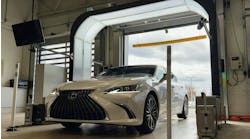Whether it is in the vehicle’s engine oil, the engine air, or the fuel system, automotive filtration is basically about removing contaminants that can cause damage and wear to a vehicle’s components. These contaminants can prevent the free flow of fluids within these systems as well as cause damage. Keeping the oil and air clean and flowing in and around the engine without any debris or obstruction will enable the vehicle to run smoothly and perform better for thousands of miles.
Clean Oil Reduces Engine WearIn the early days of the automobile there was no oil filtration, and air filtration was rudimentary at best. It was not until 1923, that Ernest Sweetland and George H. Greenhalgh developed the first automotive oil filtration system. They called their invention, “Purolator,” a combination of the words Pure Oil Later. The resulting longer oil drain intervals, cleaner oil and reduced engine wear won the admiration of the car companies and the oil filter soon became standard on Studebaker, Hupmobile, Cadillac, Buick, Dodge and optional on many other vehicles. The original oil filter was an upright series of seven twill weave cloth-covered perforated plates encased in a heavy-duty cast container. In the beginning, oil filters were crude devices that were located away from the engine. Today, these devices are directly attached to the engine.
Up until 1943, most oil filters were of the by-pass kind and able to filter only about 10 percent of the oil at a time. In 1943, Purolator developed the full-flow oil filter, with the capability of filtering 100 percent of the oil. By 1946, the full-flow oil filter became standard on most vehicles.
Filtration Technology Marches OnAs oil filter technology improved, so did the filtration media. In the 1930s filter media was made from waste cotton material. In 1946, the industry developed the paper filter element – the first pleated paper oil filter.
In the 1960s and 1970, filtration products were developed for transmission fluids, power steering fluids, hydraulics, coolants, crankcase emissions and other liquids and gases.
As time passed, filter manufacturers continued to improve the product. In 1996, Purolator, for instance, introduced the PureONE oil filter. Today, the Purolator PureONE oil filter offers the highest Micronic filtration – 99.9 percent efficiency – available on the market, according to Nunez. “The premium Purolator PureONE oil filter is engineered to trap up to 13 grams of microscopic contaminants – the equivalent of 31 standard size paper clips – that can enter and harm a vehicle’s engine, including dirt and metal shavings,” Nunez said.
Value Of Unrestricted Air Flow To The Engine
Initially, air filters were of the “oil-bath” type that then evolved into air filters fully encased in a metal canister. The idea was that when you changed your oil and oil filter, you dumped the oil and washed out your air filter. As engines became more sophisticated, the demand for a more efficient air filter became obvious. The mid 1950s saw the introduction of the first dry pleated paper type air filter. The modern air filter removes harmful contaminants such as insects, vegetable matter, dirt, dust, leaves and fine straw – all of which can harm an engine.
Types of Air Filters
There are various types of engine air filters – radial, axial, conical and panel filters. Radial filters were in use for the first 30 years after the development of dry pleated paper type air filter. This type of air filter utilized a dry pleated paper type element covered with a wire screen mesh on both the interior and exterior surfaces of the element. Panel air filters are the most popular type of air filter used in automobile and light truck applications today. Though Purolator developed panel air filters in the 1950s, they did not become popular until the 1980s. This is mainly because vehicles are being built today to be more and more aerodynamic and there is a push to utilize the space under the hood as effectively as possible.
Purolator recommends changing the air filter on your customers’ vehicles once every year unless otherwise suggested by the vehicle’s manufacturer. Vehicle owners who drive more often on dirt or gravel roads need to change the air filter more often than those who drive mostly on paved roads. A good rule of thumb is to check the air filter each time you change the oil filter. A slightly dusty look confirms it is working. However, the darker the filter, the greater the need there is to change it.
According to Nunez, “Purolator PureONE air filters are 99.5 percent efficient and offer twice the filtration capacity of conventional air filters based on ISO 5011 on PA24278. Their Micronic filtration media prevents contaminants from entering and damaging the engine and helps improve vehicle performance and gas mileage.”
Paying close attention to the condition of the oil and air filters on your customers’ cars is crucial to their longevity and long-term performance and extremely important in keeping your customers happy over the long haul. www.pureoil.com.


